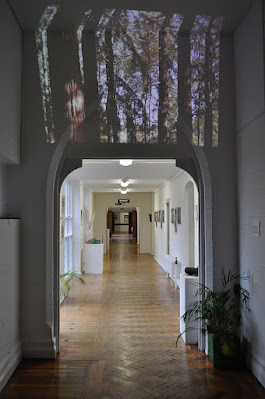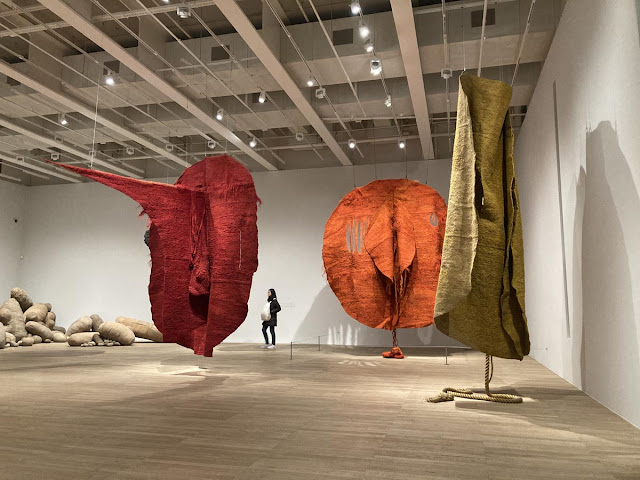- Get link
- X
- Other Apps
- Get link
- X
- Other Apps
It’s been an odd couple of months for me as I had an operation on my ankle that I’ve been waiting over a year for, so mostly I have been recovering from that. I’ve attended several virtual events, which have been interesting and inspiring, but I really missed going out into the world to see art and talk to people. It has been like my own mini-lockdown!
Although I make a lot of digital work at present, I really love seeing sculptural and 3-D work and I see myself as someone who thinks in a 3-D way. Installation was my main focus for exhibiting work before the pandemic, when I was suddenly forced by circumstance to make work for online viewing. In taking a space and projecting imagery into it, I am altering how that space feels when someone encounters it. I have often used overlooked spaces in buildings: nooks and crannies that people usually walk past without noticing them.
In 2013, I made Thereby Hangs a Tale for Meadow Arts and National Trust’s Croft Castle & Parkland, using the castle’s Slate Store, a small room that had a metal gate for a door and was filled with bits of slate and detritus from maintenance jobs; cables, reels, pipes etc. I was interested in how the castle’s interior was carefully curated, each object painstakingly looked after with its provenance noted, while this seemingly forgotten space looked a bit neglected.
 |
Rebecca Farkas, Thereby Hangs a Tale (2013) Single channel digital projection, 4m x 3m. Meadow Arts commission at Croft Castle & Parkland (National Trust). |
Twelve Trees, a piece about grief, used an area above a doorway, in a beautiful old building occupied by Hereford College of Arts. During its exhibition period, people would remark that they’d never noticed that space before, despite it being in a much-used corridor. At art college, during my degree, I used generic office spaces for my projections, creating little havens of light and colour amid the drabness of filing folders and beige walls. More recently, I projected Memento Mori II into a more interesting meeting room space at Eastside Projects in Birmingham.
 |
Rebecca Farkas, Twelve Trees, 2016-18 Single channel digital projection, 3m x 2m |
 |
Rebecca Farkas, Memento Mori II, 2019 Animated single channel digital projection, 3m x 2m |
Just before my ankle operation, I managed to get to Tate Britain to see the Cornelia Parker exhibition. I wrote about her work in my last blog post, and how she connects objects and their context to create her work. As well as using historical objects in some of her pieces, “When she saw a sword that had been owned by Henry VIII at the Tower of London, she sought permission to pierce a pillow with it.” (Tate Etc, issue 55), Parker exploded a shed filled with people’s objects, belonging to herself and her friends, along with things picked up from car boot sales. This piece of work is spectacular, giving a sense that you have somehow entered the space where an explosion, in mid expansion, has somehow been paused like a movie special effect. The exhibition was filled with objects that were displayed or altered, each holding a story of its past connections. I enjoy the way that Parker makes the mundane stand out, but also uses objects that have connections with important historical figures. Something that I admire is the way that she persuades people to allow her to use historic objects in her work or to create spectacular events (the army blew up the shed for her and collected the splintered pieces afterwards).
 |
| Cornelia Parker, Cold Dark Matter: An Exploded View, 1991 |
Another exhibition I visited in September was Forest: Wake This Ground, a group exhibition exploring the forest, above and below ground. The exhibition was quite thoughtful and varied in its exploration of the theme. A wonderful ongoing drawing in many panels, by David Nash, filled one of the walls, documenting a lifetime of making sculptures in natural materials. It’s a kind of visual timeline or diary of the artist’s work across decades. Much more interesting than a list or spreadsheet of his works!
 |
| David Nash, The Family Tree 1967 to 2019 |
This month, I have been to New Art Gallery Walsall to speak to Head of Exhibitions Deborah Robinson about my work and I also looked around their fine galleries. There’s a wonderful exhibition called Breaking the Mould, Sculpture by Women Since 1945 which contains small- and large-scale works that are very diverse in form and use of materials, often challenging the male-dominance of this field.
I enjoyed the monstrous form of Shirazeh Houshiary’s creature-like piece, made from clay and straw on wood. Phyllida Barlow’s work looks monumental at the end of one of the gallery spaces, but on closer inspection it’s a subversion of masculine ideas of scale and weight, using polystyrene amongst its materials.
 |
| Shirazeh Houshiary, Listen to the Tale of the Reed No.3, 1982 |
A chance to pop into Tate Modern when I went to London for a work event revealed more creature-like sculptures, made from sisal, that hang from the ceilings. They were created by Polish artist Magdalena Abakanowicz. Christened Abakans by a mystified reviewer in the 1970s, the sculptures have a huge presence in the large spaces of Tate and I felt the need to sit with them for a long time. I kept catching the eye of a woman in the gallery and it turned out that we do know each other from something, but neither of us knew what that something was. We had a conversation in which we marvelled at these amazing pieces of work and wondered that neither of us had heard of this artist before. I will return to see this show again, if I get the chance, as it really moved me.
 |
| Magdalena Abakanowicz, Abakans (at Tate Modern) |
There is a lot of value in the increase in online art events, and I think that a mixture of live and online is best wherever possible, as it allows access to art for many more of us than is otherwise possible.
The chance encounters are what is often missing from the digital experiences that are on offer. It’s very hard to have the opportunity to chat with a stranger (or a vaguely familiar person) at an online talk. In fact, some of these events deliberately switch off the chat function so you can’t do this. The joy of being in a physical space with the art cannot be replicated online, and the scale and awe of some of these works cannot be represented in photos in the same way as the actual experience. I came across Abakanowicz’s work by accident, when I got out of the lift on the wrong floor, and perhaps that adds even more pleasure to the discovery of her work.



Comments
Post a Comment